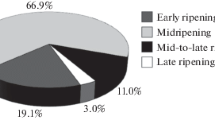Abstract—The adaptability and stability in productivity of nine cultivars and lines of covered oats were studied in parallel competitive tests in two ecological points of the Kirov region (Kirov city and settlement Falenki) for their perspective use in production. The index of environment conditions (I) changed in 2018 from a negative indicator in Kirov (–10.50) to a positive one (3.86) in Falenki. In 2017, it amounted to 3.39 and 3.26, respectively. Perspective lines of the intensive type I-4592 and I-4808 having average productivity of 64.4 and 63.8 c/ha and sympathetic for change of environment conditions in a section of years and ecological points (bi = 1.59 and bi = 1.37; \(S_{i}^{2}\) = 21.58 and \(S_{i}^{2}\) = 9.78) were selected. The productivity of the I-4808 line was 6.0 c/ha higher than the standard productivity. It showed higher stress resistance and stability of productivity compared to the I-4592 line and was transferred to the state test as a Falenets cultivar. A wide range of adaptive features and resistance to stress factors were recorded for the perspective line 2h12o at high average productivity (61.6 c/ha), regression coefficient near to 1 (bi = 0.94), and high genetic flexibility ((Ymin + Ymax)/2 = 60.2 c/ha). Sapsan, Medved, and Berber cultivars belong to the semi-intensive genotypes capable to form productivity stable by years. Significant positive correlations between productivity and genetic flexibility (r = 0.93), between coefficient of regression and indicators of variation (r = 0.90) and stability (r = 0.92), and insignificant positive correlations with variance of stability (r = 0.09) were established.
Similar content being viewed by others
REFERENCES
Pakul’, V.N., Martynova, S.V., and Androsov, D.E., Assessment of adaptive ability and stability of spring barley in the conditions of the northern forest-steppe of the Kuznetsk depression, Dostizh. Nauki Tekh. APK, 2018, vol. 32, no. 1, pp. 32–34.
Pereira, H.S., Alvares, R.C., Silva, F.C., de Faria, L.C., and Melo, L.C., Genetic, environmental and genotype x environment interaction effects on the common bean grain yield and commercial quality, Semina: Cienc. Agrar., 2017, vol. 38, no. 3, pp. 1241–1250.
Admas, S. and Tesfaye, K., Genotype-by-environment interaction and yield stability analysis in sorghum (Sorghum bicolor (L.) Moench) genotypes in North Shewa, Ethiopia, Acta Univ. Sapientiae,Agric. Environ., 2017, no. 9, pp. 82–94.
Gedif, M., Yigzaw, D., and Tsige, G., Genotype-environment interaction and correlation of 625 some stability parameters of total starch yield in potato in Amhara region, Ethiopia, Plant Breed.Crop Sci., 2014, vol. 6, no. 3, pp. 31–40.
Hincha, D.K., Zuther, E., and Obel, N., Fructans from oat and rye: Composition and effects on membrane stability during drying, Biochim. Biophys. Acta,Biomembr., 2007, vol. 178, no. 6, pp. 1611–1619.
Des Marais, D.L., Hernandez, K.H., and Juenger, T.E., Genotype-by-environment interaction and plasticity: Exploring genomic responses of plants to the abiotic environment, Annu. Rev. Ecol. Evol. Syst., 2013, vol. 44, pp. 5–29.
Povilaitis, V., Lazauskas, S., Antanaitis, Š., Feizienė, D., Feiza, V., and Tilvikienė, V., Relationship between spring barley productivity and growing management in Lithuania’s lowland, Acta Agric. Scand.,Sect. B, 2018, vol. 68, no. 1, pp. 86–95. https://doi.org/10.1080/09064710.2017.1367834
Hill, C.B. and Li, C., Genetic architecture of flowering phenology in cereals and opportunities for crop improvement, Front. Plant Sci., 2016, no. 7, p. 1906. https://doi.org/10.3389/fpls.2016.01906
Lorenz, A.J. and Smith, K.P., Adding genetically distant individuals to training 668 populations reduces genomic prediction accuracy in barley, Crop Sci., 2015, vol. 55, pp. 2657–2667.
Muslimov, M.G., Taimazova, N.S., and Arnautova, G.I., Comparative characteristics of productivity elements among film and huskless forms of oat, Int. J. Ecol. Dev., 2017, vol. 32, no. 4, pp. 130–137. https://elibrary.ru/contents.asp?id=34591925.
Gadisovich, M.B., Kurkiev, K.U., and Muslimov, M.G., Comparative characteristics of productivity elements among film and huskless forms of oat, Int. J. Green Pharm., 2017, vol. 11, no. 3, pp. 502–507. https://elibrary.ru/contents.asp?id=34587262.
Nikolaev, Yu.N. and Androsov, O.V., Seed production and nursery of the Russian Federation: Analytical statistics, Vestn. Rossel’khoztsentra, 2018, no. 1, pp. 13–16.
Metodika gosudarstvennogo sortoispytaniya sel’skokhozyaystvennykh kul’tur (Methodology of State Variety Testing of Crops), Moscow, 1985.
Pakudin, V.Z. and Lopatina, L.M., Assessment of environmental plasticity and stability of crop varieties, S-kh. Biol., 1984, no. 4, pp. 109–113.
Sapega, V.A., Genotype–environment interaction, productivity, and adaptive potential of spring wheat varieties, Russ. Agric. Sci., 2019, vol. 45, 323–329. https://doi.org/10.3103/S1068367419040153
Goncharenko, A.A., On adaptability and environmental sustainability of cereal varieties, Vestn. Ross. Akad. S-kh. Nauk, 2005, no. 6, pp. 49–53.
Sokolenko, N.I. and Komarov, N.M., The source material for breeding of winter wheat for productivity and the most important adaptive traits, Dostizh. Nauki Tekh. APK, 2016, vol. 30, no. 9, pp. 26–29.
Sainakova, A.B. and Litvinchuk, O.V., Assessment of environmental plasticity and stability of oat collection samples by weight of 1000 grains, Vestn. Kemer.Gos. Univ., 2015, vol. 3, no. 4, pp. 72–74.
Author information
Authors and Affiliations
Corresponding authors
Ethics declarations
The authors declare that they have no conflict of interest. This article does not contain any studies involving animals or human participants performed by any of the authors.
Additional information
Translated by M. Shulskaya
About this article
Cite this article
Batalova, G.A., Tulyakova, M.V., Zhuikova, O.A. et al. Adaptive Potential for Perspective Lines and Cultivars of Covered Oats Bred in the Federal Agricultural Scientific Center of the Northeast. Russ. Agricult. Sci. 46, 203–206 (2020). https://doi.org/10.3103/S1068367420030039
Received:
Accepted:
Published:
Issue Date:
DOI: https://doi.org/10.3103/S1068367420030039



